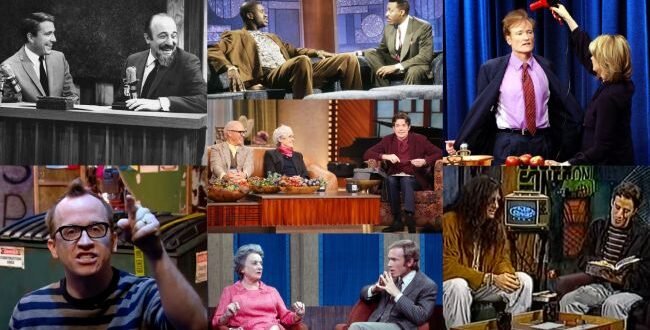If someone were to build a machine that could create the perfect comedian for late-night television, it might spit someone out like John Mulaney. Born in Chicago in 1982, one of the first glimmers he had of his eventual hunger for the limelight was watching Ricky Ricardo perform with his band on reruns of “I Love Lucy” and both embracing and mocking that old-world sense of showmanship has been part of his charm ever since.
During his youth, Mulaney would also spend time watching archived episodes of “The Tonight Show with Johnny Carson” at the Museum of Broadcast Communications, likely finding inspiration in Carson’s mix of childlike playfulness and debonaire affect. Whereas most stand-ups of his generation perform in casual threads, Mulaney is known for regularly donning a suit in both his specials and appearances, perhaps a nod to Carson or his own way of recognizing the importance of formality even when your job is to make people laugh.
And yet, for his own venture into late-night, it would seem Mulaney’s interests diverge heavily from that of Carson’s 30-year legacy. Sure, Mulaney wears many suits on “Everybody’s Live” that Carson would’ve admired and the set decor certainly harks back to the personality’s 1970s heyday, but its jazz-like flow and unabashed oddness is far from the hip, if not slightly straightforward, hangout “The Tonight Show” tended to offer for most of the second half of the 20th century. If anything, Mulaney is making fun of Carson’s style to a certain extent as much as he’s paying homage to it, side-stepping the organization and format he and other late-night icons who followed in his path worked to shape and instead creating space for as much chaos and unpredictability as possible. It would seem Mulaney isn’t purely interested in having a good time or keeping up with popular culture, but instead relishes the opportunity to curate a one-of-a-kind experience with each episode.
While this may seem new or unusual, he’s by no means the first late-night personality to offer viewers something unconventional. Every decade in fact seems to have had its own rabble-rouser whose shunning of norms have pushed the medium further and further, even if their own material was too out-there to gain a wide audience. Keep reading to find out all the late-night legends who paved the way for “Everybody’s Live with John Mulaney.”
The Merv Griffin Show
Most people alive today will have heard of Merv Griffin because of the “Seinfeld” episode titled “The Merv Griffin Show,” in which Kramer finds the old late-night show’s set in a dumpster and decides to pretend like it’s still on the air with him as host. However, having grown up with parents who came of age during the ’60s and ’70s, it was hard not to hear his name brought up without a laugh and a shake of the head in my household. From 1962 to 1986, airing on NBC, CBS, and in syndication, “The Merv Griffin Show” was a repository for both intellectual conversation and light-hearted amusement.
With guests like Martin Luther King, Jr., anti-war activist Abbie Hoffman, and artist Salvador Dalí, Griffin was committed to platforming voices many considered taboo, while also inviting on beloved celebrities like Robert De Niro, Grace Kelly, Richard Pryor, and more. Like Griffin, Mulaney is happy to have some fun with friends, but also wants to use his show as an opportunity to learn more and let audiences do so as well. Also similar to Griffin, Mulaney is adept at creating a communal environment. He works hard not to put the attention on any one person, even himself, therefore allowing us to feel like we’re sitting in on a shared conversation.
The Dick Cavett Show
Like Griffin, Dick Cavett was a staple of mid to late-20th century late-night and morning talk shows, hosting his program on ABC, CBS, and PBS between 1968 and 1986. Set up as a contrast to Carson’s Hollywood appeal, Cavett mostly shot in New York and often welcomed authors, politicians, and other figures outside of entertainment. Mulaney has retained this practice to a certain degree by always leaving room for at least one guest who retains a relatively normal job or expertise in a specific field that often has nothing to do with film and television. In terms of demeanor, Cavett and Mulaney also share a lot in common, as both are known for infusing their comedy with a certain level of intellect and intrigue. And as with Carson, all three enjoy a flashy sports coat from time to time.
Another element that tie Cavett and Mulaney is their interest in the unknown. For Cavett, this meant offering space for conflicting points-of-view and engaging them in thoughtful, yet still pointed conversations on their specific topic of expertise. Mulaney works with the unknown in a somewhat different fashion. While he does offer a specific focus within each episode like “Lending People Money,” “Cruises,” and “Funeral Planning,” these mainly serve as a lifeline to pull focus back from Joan Baez making political statements, comedian Luenell trying to score with Pete Davidson, and delivery robot Saymo providing guests with generically branded beverages.
The Arsenio Hall Show
Stylistically, Mulaney and Arsenio Hall definitely share that special rizz that makes one feel cool just for tuning in. They also both have a strong sense for studio audience participation and want their guests to let loose and be themselves. This less formal approach to late-night appeals greatly to younger generations and has allowed for iconic moments that enter the cultural memory even beyond television. For instance, with Hall, by having then-Governor Bill Clinton play saxophone with the house band, performing “Heartbreak Hotel,” late-night TV very well might’ve helped elect our 42nd President. Seeing Joan Baez dance to Cyprus Hill on “Everybody’s Live” may not make an impact on that scale, but the image will stand in many’s memories for a long time to come.
The Jon Stewart Show
Jon Stewart would eventually go on to much greener pastures with his long-held gig hosting “The Daily Show” on Comedy Central, but before he landed that, he actually served as a replacement for Hall, whose show was canceled in the midst of a merger between Paramount and Viacom, parent company for the then-increasingly popular MTV Network. “The Jon Stewart Show” would only last two seasons and rarely offered moments worth remembering, though it did provide a platform for talent like Howard Stern and Conan O’Brien. However, in Stewart’s presentation, there is some similarity with Mulaney’s overall gonzo approach.
Both are ringleaders of the highest order, always ready with a quip and a segue that highlights just how strange the act of talking on television for a living can be. Though Stewart may have been interested in deconstructing the late-night format in the same way Mulaney continues to find new ways to do, he was likely hamstrung by the needs of a newly formed media entity that hadn’t yet found solid ground. Even the broken-down, basement-like set the show started with was ultimately revamped to have more of refined appeal. The one benefit to Mulaney doing his show nowadays and at this point in his career is that he really can do anything he wants, offering the same kind of wacky and out-there dialogue Stewart perhaps wished to have, but was never fully able to.
Conan O’Brien
Oh, Conan. What a guy. Perhaps I’m biased because we share the same birthday and a similar flare for the dramatic, but Conan O’Brien has been and remains the best personality to ever come out of late-night. After years writing on “Saturday Night Live” and “The Simpsons,” O’Brien was given his own launch pad in 1993, when David Letterman moved from NBC to CBS after “The Tonight Show” was given to Jay Leno. Replacing Letterman was no small feat, but O’Brien did so with gusto right out of the gate, displaying a confidence and brand of humor that felt both familiar and fresh. Like O’Brien, Mulaney also benefits from having a proven track record, though his is no doubt much longer and more varied having not only written for and hosted “SNL,” but also performed on Broadway, helmed a number of specials, and had his own sitcom for a brief stint.
Nonetheless, Mulaney owes a lot to O’Brien’s go-for-broke attitude and his ability to take what he’s learned and spin it into comic gold. They both share an appreciation for sketch humor, whether that be in the form of a pre-taped bit or a character who’s found their way into the audience like Tracy Morgan’s King Latifah or a pre-“SNL” Amy Poehler playing sister to O’Brien’s sidekick, Andy Richter. Though “Everybody’s Live” announcer Richard Kind may appear to have more in common with Carson’s Ed McMahon, his shtick both with Mulaney and independent of him feels reminiscent of the dynamic O’Brien set up with Richter. Even when there’s a joke Kind may not fully understand, he has no problem giving it his all and provides a heightened counterpoint to Mulaney’s relative laid-back nature.
The Chris Gethard Show
Very few people are likely to have ever heard of “The Chris Gethard Show” and that’s kind of what makes it so special for those of us who have. Even Chris Gethard himself is not a comedian many have heard of unless you’re deep in the comedy scene. He’s appeared on “Parks and Recreation” and had a strong supporting role in Mike Birbiglia’s “Don’t Think Twice,” but never found the mainstream success Mulaney has been able to achieve. Starting out at UCB in New York, Gethard created a live show around his own taste for edge and discomfort, building an audience of misfits who relished their chance to be part of this weird little community.
Eventually, “The Chris Gethard Show” found a place on public access TV in New York, though viewers could watch internationally as well if they wished to. It was here that the show really found its voice, with a colorful cast of characters around Gethard that included co-host Shannon O’Neal, phone operator Bethany Hall, announcer Murf Meyer, the Human Fish, Vacation Jason, and more. Instead of studio seating, Gethard’s crowd mostly sat on the floor, and rather than focus on promoting upcoming projects, his guests instead were invited to participate in whatever theme the comedian and his staff imposed during each episode, whether that was inviting on a dominatrix to abuse Gethard or hosting a night for people to come make sandwiches. Even Mulaney was an early supporter during this iteration.
“The Chris Gethard Show” would eventually get a chance to crossover when it was picked up on Fusion. Gethard was able to get bigger guest names and his antics became more intricate, like an entire episode spent playing “Guess What’s in the Dumpster” with Paul Scheer and Jason Mantzoukas that ends with a reveal that may best Darth Vader turning out to be Luke’s father. Mulaney also appeared again when the show moved to truTV, where it was canceled after its third season.
Though far more chaotic than what Mulaney is offering on “Everybody’s Live,” there is no doubt a connection between the two shows as playfulness and audience engagement are inherent to their comedy. Like Gethard, Mulaney also utilizes a phone-in gimmick that gives those watching at home a chance to be a part of the fun.
Source link



